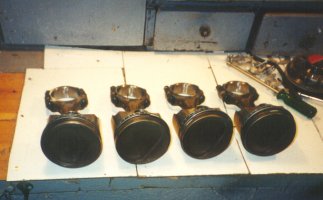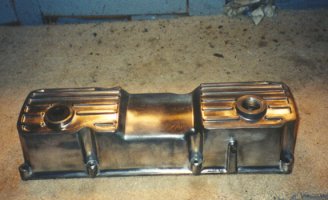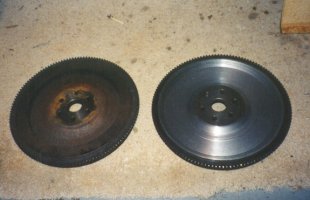Page 1
Page 2 Page 3 Page 4 Page 5 Page 6 Page 7 Page 8 Page 9 Page 10
|
 |
These are the original pistons and connecting rods. The rods are the same as the N/A 2.3 rods,
but the forged 8:1 pistons are one of the major differences in the N/A and turbocharged engines. The rods
are good up to around 400 horsepower, and the stock pistons are good for that and more. I did not have
these modified for full-floating pins, which is another common upgrade. I'm just using Sealed Power rings,
as this build of the engine is just to get me started. If I continue with the project, I'll put one together
with Crower Sportsman rods, Diamond forged pistons on full-floating pins, and gapless rings. |
| If it doesn't make you go faster, chrome it! Actually, this is the stock 88 TC aluminum valve cover that's been stripped with aircraft stripper, wire-brushed to remove the remaining paint, and polished using stuff
from Eastwood company, then clear-coated for durability. I was very happy with how this came out, and it's
holding up quite well to time, heat, and general engine bay abuse. I originally put it on with a cork gasket
from a gasket kit intended for the 88 TC, but I've since replaced that with a rubber gasket for the Ranger,
and it seals much better in addition to being reusable. |
 |
 | This is a comparison of the flywheels. On the left is the original 2.0 flywheel, on the right is one from an SVO that I had turned and lightened. I had about 5 pounds taken out of it. This is not recommended on an iron flywheel like the stockers, and I do plan to change it to a steel one eventually. But I'm not going to be dropping the clutch at high rpms or anything like that - this isn't planned to be a drag truck. It should be ok for my purposes. |
| The engine assembled on the stand. This is the passenger side, and you can see the brass fitting for the turbo oil return line, which is the only difference between the N/A and turbocharged engine blocks. This is using the stamped steel oil pan from the TC, and it works fine in the Ranger. The aluminum oil pan from the Ranger will also work, but may need some grinding for clearance on the oil pan. An advantage of using the Ranger oil pan with the Ranger transmission is that there are two holes in the back of the oil pan that the transmission bolts to, stiffening that assembly. But leaving those holes out doesn't hurt anything, and since I didn't have a grinder to address the aluminum oil pan, I went with the steel. |
 |
 |
|
